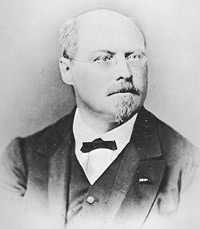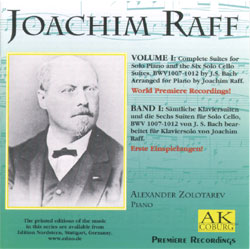| Join the International Draeseke Society and receive a substantial discount on your order. |
| AK/Coburg Recordings International Draeseke Society/NA - Box 104, Sand Lake, NY 12153 USA |
JOACHIM RAFF SUITE NO. 2 in C MAJOR for PIANO, Op. 71
1. Preludio All begin with a prelude, continue with a dance piece followed by a more virtuoso composition, then a slow movement for relaxation and finally a fugue. None of the three first piano suites of Raff exceed 20 minutes and the AK/Coburg performance of Op. 71 clocks in at an appropriate 18:18.The first movement Prelude is marked Andante, 4/4 and as expected, is in C major. Though harmonically of its time, there is a visual outline very reminiscent of movements by Bach with similar title. More in keeping with the 19th century (but also with the Baroque suite as a collection of  dances) is the second movement duple time Polka in E flat major: a deliciously quirky little dance and perhaps technically the most difficult section of the suite. This Polka seems to have proven popular enough when issued separately that it achieved more printings than the two other sections of the suite issued separately, the Toccatina and Romanza. The Toccatina third movement is marked Molto vivace. The evenness in its invention belies the duple meter indication, especially since the left hand plays triplets throughout and the dotted rhythm of the right hand thematic material almost obviates the 2/4 indication. Essentially binary in form, the second thematic group presents contrast with a steady pulse involving quarter notes and half notes. A return of the faster material is short lived, the second theme returns and a quick flourish of the main idea ends the movement. The fourth movement Romanza (Andante non troppo, ¾, A minor), is the only movement in a minor key. in the suite It is a lovely manifestation of Raff's ingratiating lyricism and perhaps the harmonically most venturesome movement of the work. Syncopation is discreetly used to increase tension and there is a contrasting section in E flat major just after the beginning of the piece which brings in the contrasting second theme and upon return to A minor the music is built to a climactic section, essentially lyrical and relaxed, before ending in the lower bass register. The Fuga is Raff's obvious salute to the Baroque suite in this composition. It begins with a somewhat lengthy virtuoso gesture before the actual fugue theme appears. The episode material, though harmonically contrasting, is rather parallel to the fugue theme. Momentum builds and the movement concludes in true virtuoso manner. dances) is the second movement duple time Polka in E flat major: a deliciously quirky little dance and perhaps technically the most difficult section of the suite. This Polka seems to have proven popular enough when issued separately that it achieved more printings than the two other sections of the suite issued separately, the Toccatina and Romanza. The Toccatina third movement is marked Molto vivace. The evenness in its invention belies the duple meter indication, especially since the left hand plays triplets throughout and the dotted rhythm of the right hand thematic material almost obviates the 2/4 indication. Essentially binary in form, the second thematic group presents contrast with a steady pulse involving quarter notes and half notes. A return of the faster material is short lived, the second theme returns and a quick flourish of the main idea ends the movement. The fourth movement Romanza (Andante non troppo, ¾, A minor), is the only movement in a minor key. in the suite It is a lovely manifestation of Raff's ingratiating lyricism and perhaps the harmonically most venturesome movement of the work. Syncopation is discreetly used to increase tension and there is a contrasting section in E flat major just after the beginning of the piece which brings in the contrasting second theme and upon return to A minor the music is built to a climactic section, essentially lyrical and relaxed, before ending in the lower bass register. The Fuga is Raff's obvious salute to the Baroque suite in this composition. It begins with a somewhat lengthy virtuoso gesture before the actual fugue theme appears. The episode material, though harmonically contrasting, is rather parallel to the fugue theme. Momentum builds and the movement concludes in true virtuoso manner. |
Read a review at raff.org. Review from Piano Magazine. Listen to a portions of Suite No. 2. See an image of the compact disc with complete track listings. |

